Organic Onion Growing:
The following is all about Organic Onion Growing.
Introduction to Organic Onion Growing
The onion, also known as the bulb onion or common onion is a vegetable that is cultivated species of genus Allium. There are a variety of shapes and sizes in onion. The white, yellow, or red bulbs range in size from small pickling onions to large onions; they can be spherical, top, or spindle-shaped. The onion plant has an aficionado of empty pale blue-green leaves and its globule at the base of the plant starts to swell when a specific day-length is come to. The knobs comprise little, compacted, underground stems encompassed by meaty leaves that encase a focal bud at the tip of the stem. The leaves are yellowish-to pale blue-green and develop then again in a smoothed, fan-formed cover. They are beefy, empty, and round and hollow, with one levelled side. They are at their broadest about a fourth of the path up, past which they decrease towards a limit tip. The base of each leaf is a levelled, generally white sheath that becomes out of a base plate circle. From the underside of the circle, a heap of sinewy roots stretches out for a short path into the dirt. As the onion grows, food reserves begin to concentrate in the leaf bases, and the bulb of the onion swells. The main characteristic of onion and other crops is their sourness, and because of this, they are probably the most vital dietary ingredient in the world. In general, they are used for salad, pickling, cooking, etc. In South-East Asia onions are eaten in cooked dishes. Onion also plays an important role in conventional medicine. Recently its role in decreasing both the blood sugar level and platelet aggregation was discovered. The origin of the onion is debated by many historians and botanists alike as evidence was found that it was used in Asia and America. Under a proper vegetable farming business plan we can obtain decent profits in organic onion growing.
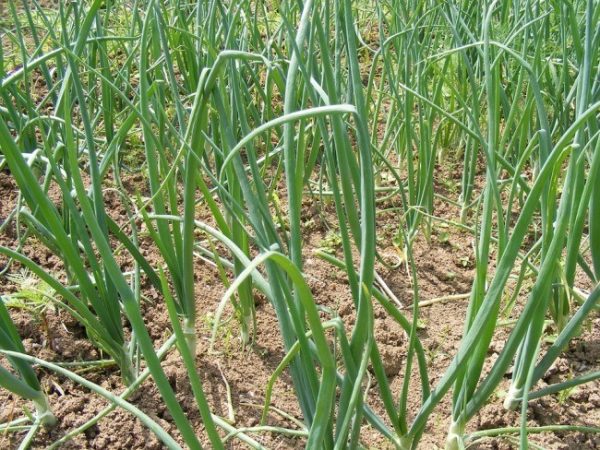
Organic Production of Onion
Organic production of onion is a comprehensive system designed to increase the productivity and fitness of distinct communities within the agroecosystem, including soil organisms, plants, livestock, and people. The prime goal of organic production is to ensure healthy vegetable growth Organic onions can be grown outdoor, indoors, in greenhouse, Polyhouse.
Common Name: Onion.
Biological Name: Allium cepa.
Major Onion Production Countries
When it comes to production, China tops the list followed by India and United States. Below is the list of Top Onion producing countries:
- China.
- India.
- The United States.
- Pakistan.
- Turkey.
- Egypt.
- Russia.
- Brazil.
- Mexico.
- Japan.
Organic Onion Varieties / Cultivars
There are lots of different onion varieties that can be grown using organic methods. These varieties can be divided into four main categories – white onions, yellow onions, red onions and bunching onions. The varieties vary in sourness levels, size, and shape.
White Onions – These varieties are usually white and are average sweet. Can be used raw or cooked. Subtypes include snow white hybrid, white white, white granex.
Yellow Onions – these varieties are usually the sweetest, with gold skin on the outside and off-white or light yellow flesh on the inside, usually the best varieties for cooking. Sub-types of yellow onions include Candy hybrid, walla walla sweet, Granex yellow hybrid, Texas super sweet, sweet and early hybrid, Texas grano, sweet Spanish hybrid, yellow Ebenezer, savannah sweet.
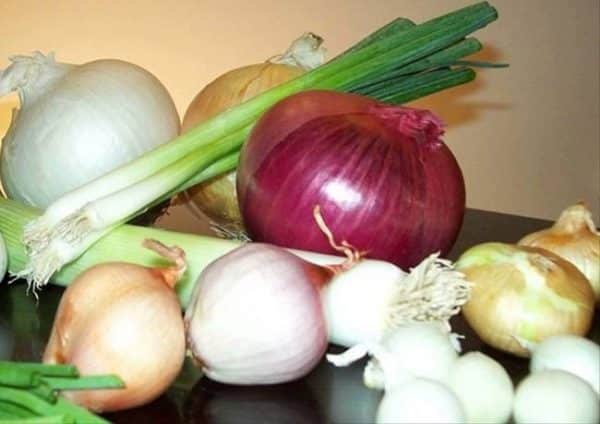
Red Onions – these onion varieties are traditionally eaten raw on sandwiches or in salads, typically have red skin and red and white flesh, very crisp, don’t typically store very well. Sub-types of red onions are Giant red hamburger, salad red, red delicious.
Bunching Onions – Also known as Chinese onions – these onion varieties never form a bulb and are used for scallions or green onions, which typically don’t store well. Subtypes of bunching onions include Evergreen long white, parade, white Lisbon.
Suitable Climatic Conditions for Organic Onion Growing
Onions can be planted during different times of the year. The climate of the environment will be a deciding factor as to which onion to grow at what time. There are two main types of onions.
1) Short type.
2) Long type.
These varieties are grown at different times of the year. Short-day assortments are basically developed in hotter atmospheres amid the wintertime. These sorts of onions do best when there are around 12 hours of light. Long-day assortments are developed in colder districts and do best when sunshine hours reach out to 15-16 hours. In warm atmospheres with gentle winters, most people plant short-day onion assortments in the fall. In cooler atmospheres, difficult day onion assortments are planted in the late winter, when the dirt is workable. Ordinarily, onions are a cooler season edit and don’t do well in an exceptionally sweltering climate. In the event that you are in question about when to plant onions, you’ll presumably be in an ideal situation beginning in the late winter.
Soil Requirement for Organic Onion Growing
When growing onions organically, the dirt ought to be free and breezy to a depth of 8 inches. Moreover, the dirt should deplete well. In the event that the dirt remains waterlogged, the onions will spoil before they have an opportunity to develop. Likewise, they ought to be planted in a place that gets 6-8 hours of direct daylight day by day.
Propagation of Organic Onion Growing
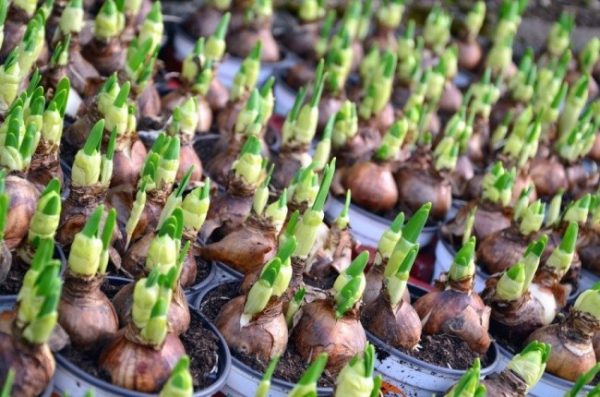
There is a choice of three methods when it comes to growing onions organically this includes growing through seeds, seedlings, and sets.
Growing onions from seed offer the great advantage of a variety of choices in cultivars. The challenge with starting from seeds is that your crop will take up to 4 months to mature— people trying to grow onions organically from cold-winter areas have to start their onion seedlings indoors.
Onion seedlings, also known as starts, can be planted directly in the field. Onion seedlings come in bundles. They are basically a group of onion plants about the thickness of a pen.
Sets are baby bulbs grown the previous year. The choices of cultivars when we plant seedling is less. They are the easiest to plant, the earliest to harvest, and the least susceptible to diseases.
Seed Rate for Organic Onion Growing
For common big onions, 8 to 10 kg seed is enough for growing seedlings/hectare, consisting of 100 to 110 beds of 3m X 0.6m size each. For sowing the bulbs in rows, 20 kg to 25 kg seed is enough for a 1-hectare field. For onions, 10 to 12 quintal bulblets are necessary for planting one hectare.
Sowing / Planting Season for Organic Onion Growing
Sowing or transplanting of seedlings can be carried in any weather condition. The optimum time for sowing the onion bulbs/seed in transplanting in the fields for optimum yield and better quality is different for different regions. Monsoon is a preferable season in any region. It can be sowed by an irrigated facility. Greenhouse or Polyhouse planting can be done at any time of year.
Plant Spacing for Organic Onion Growing
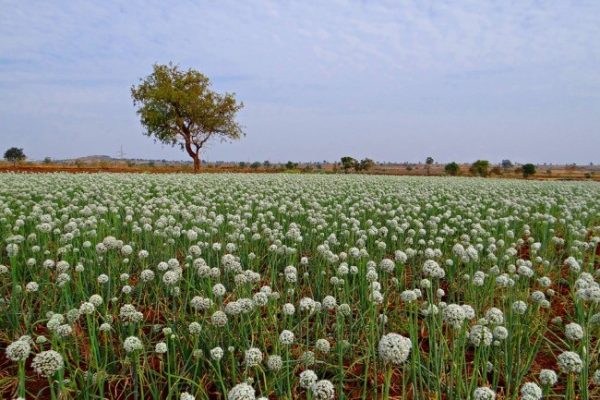
Elevated beds of about 3 meters long, 0.6 meters wide, and 20 to 30 cm high are prepared. Approximately 70 cm of distance is kept between two beds.
Read this: Organic Terrace Gardening.
Growing Organic Onions in Containers
Onions can be grown in small containers or pots by planting the seedlings or seeds of onions in a conditioned soil environment.
Water Requirement for Organic Onion Growing
A drip irrigation system is the most recommended irrigation watering system for organic onions. A soaker hose is also an affordable style. You can also use a flexible sprayer attached to the end of a hose. Set the sprayer on the mid setting and give your onion plants enough water to make the soil on top very moisturized. A watering can also be used as long as you don’t wash out the mud near the bulbs.
Fertilizers in Organic Onion Growing
Start sprinkling a balanced organic fertilizer or compost every two to three weeks after planting. This should be done on top of the original fertilizer trench @ half cup/ten feet or row and water.
Weed Control in Organic Onion Growing
Weed growth can hinder the growth of onion seedlings as the growth of organic onions is relatively slower than that of other organic vegetables. The natural preventive measures include the usage of herbicides that are organic and natural. Clove oil, vinegar, and ammonium pelargonate have received are also great methods for controlling the growth of weed.
Insect Pests and Diseases in Organic Onion Growing
Notable diseases of onion are White rot, bacterial blight, fusarium wilt, Iris yellow spot, Pinkroot, Downy mildew, and Purple blotch. Insect pests consist of onion thrips, armyworms, cutworms. For pest and disease control methods contact your local horticulture department.
Harvesting of Organic Onions
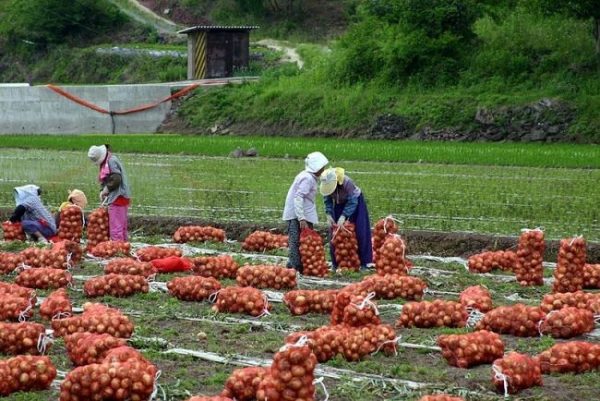
It’s an ideal opportunity to reap when the highest points of the onions turn dark-colored or yellow and fall over. Twisting the tops over early will diminish bulb estimate. Legitimate treatment at collect amplifies stockpiling time. Force the onions at a young hour toward the beginning of the day on a radiant day and dry (“cure”) the onions in the sun for two to three days. To anticipate sunscald, lay the highest points of one line over the bulbs of another. Onions must be cured completely to keep away from decay issues. At the point when legitimately cured, the whole neck (where the leaves meet the globule) ought to be dry the distance to the surface of the onion, and the skin will have a uniform surface and shading. On the off chance that the climate does not allow outside curing, you can dry your onions inside by laying them out in an all-around ventilated region. Drying inside may take longer than outside. Once the onions are completely dry, cut the roots and slice back the tops to one inch or twist uncut tops together and hang onions in a very much ventilated area.
The yield of Organic Onions
Yield is dependent on variety, soil, planting method, irrigation, and other cultivation practices. In the October-march season, The yield of onion is around 25 to 30 tons per hectare, while in July-October it is comparatively low. On average one can obtain 150 to 200 quintals per 1-hectare crop.
Marketing of Organic Onion
Harvested organic onions can be sold near your local organic stores.
Organic Onion Growing Tips
- Placing a thin layer of sand around onion bulbs may discourage adult flies from laying their eggs at the bottoms of the plants.
- Scarcely obvious onion thrips tend to assault amid a sweltering, dry climate in July or August. They deliver disfigured plants with shimmering blotches on the takes-off. Thrips overwinter in weeds, so diminish bother populaces by keeping the garden clean.
- Try spreading a reflective mulch, such as aluminum foil, between rows to confuse the thrips.
- Apply neem to control a serious infestation.
- These problems are caused by fungi in the soil and can be avoided by rotating crops and by working humus into the onion bed to provide good drainage.
In case if you are interested in this: How To Grow Organic Lettuce.
- How to Make Houseplants Bushy: Effective Tips and Ideas
- Innovative Strategies for Boosting Coconut Pollination and Yield
- Pollination Strategies for Maximum Pumpkin Yield
- The Complete Guide to Chicken Fattening: Strategies for Maximum Growth
- Natural Solutions for Tulip Problems: 100% Effective Remedies for Leaf and Bulb-Related Issues
- Revolutionizing Citrus Preservation: Towards a Healthier, Greener Future
- Natural Solutions for Peony Leaf and Flower Problems: 100% Effective Remedies
- Maximizing Profits with Avocado Contract Farming in India: A Comprehensive Guide
- Natural Solutions for Hydrangea Problems: 100% Effective Remedies for Leaf and Flowers
- The Ultimate Guide to Choosing the Perfect Foliage Friend: Bringing Life Indoors
- From Sunlight to Sustainability: 15 Ways to Use Solar Technology in Agriculture
- The Ultimate Guide to Dong Tao Chicken: Exploring from History to Raising
- The Eco-Friendly Makeover: How to Convert Your Unused Swimming Pool into a Fish Pond
- Mastering the Art of Delaware Chicken Farming: Essentials for Healthy Backyard Flocks
- 20 Best Homemade Fertilizers for Money Plant: DIY Recipes and Application Methods
- How to Craft a Comprehensive Free-Range Chicken Farming Business Plan
- Brighten Your Flock: Raising Easter Egger Chickens for Beauty and Bounty
- How to Optimize Your Poultry Egg Farm Business Plan with These Strategies
- Subsidy for Spirulina Cultivation: How Indian Government Schemes Encouraging Spirulina Farmers
- Ultimate Guide to Raising Dominique Chickens: Breeding, Feeding, Egg-Production, and Care
- Mastering the Art of Raising Jersey Giant Chickens: Care, Feeding, and More
- Ultimate Guide to Raising Legbar Chickens: Breeding, Farming Practices, Diet, Egg-Production
- How to Raise Welsummer Chickens: A Comprehensive Guide for Beginners
- How to Protect Indoor Plants in Winter: A Comprehensive Guide
- Ultimate Guide to Grow Bag Gardening: Tips, Tricks, and Planting Ideas for Urban Gardeners
- Guide to Lotus Cultivation: How to Propagate, Plant, Grow, Care, Cost, and Profit
- Agriculture Drone Subsidy Scheme: Government Kisan Subsidy, License, and How to Apply Online